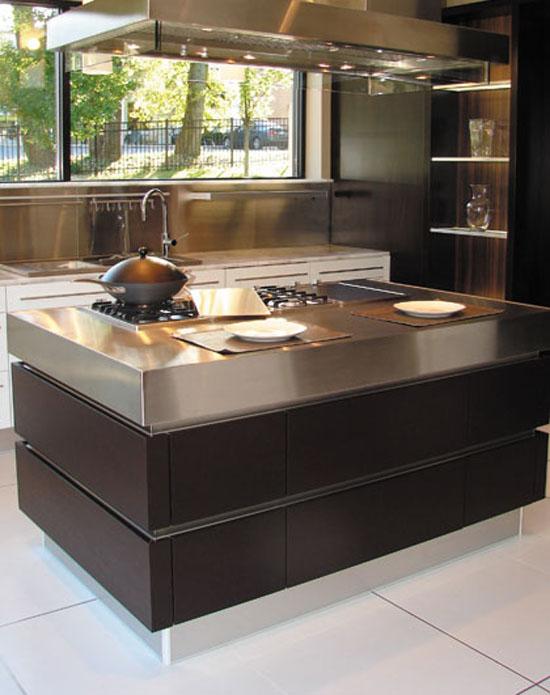Designer Forum - November 2009
By Susan Drake
Let’s look at some of the choices for the floor of the room we call “the heart of the home.” It is, after all, the room we spend many of our waking hours in, break bread in, and share our lives in. It is the core of our family and social life, and as such deserves some extra consideration when choosing flooring finishes. That said, there are a number of new products, and revivals deserving new scrutiny, to be examined.
As designers, aesthetics tend to be foremost in our minds; however there are a number of considerations to take into account. The kitchen has, in most cases, become part of a larger, more open, family space or “great room.” Hence, the question of where and how adjoining materials interface becomes significant. Additionally, the ability levels, ages, and any special needs of the immediate and extended family as well as the planned occupancy period should be considered. That is, whenever possible, universal design principals should be applied. If a wheelchair is in use or elderly occupants who do not always pick up their feet are present, a rough, uneven stone or slate, or raised or uneven transitions or saddles, would be poor choices.
Traditional selections and client preferences vary widely by region and climate. Ceramic tile is still the strongest contender in the southern and western parts of our country. Easy to clean, with many appealing choices in reasonable price ranges, it imparts a welcome coolness in warmer climates. Conversely, in the Northeast, where I practice in the high end market, most of my clients elect to continue their wood floors from the main areas of the home right in to their kitchen space, and are very adverse to any product that involves grout.
One trend I see in the general design world that has definitely spilled over into the kitchen arena is that of bringing commercial products into residential use. It’s been very prevalent in appliances, sinks and faucets, and lighting, so why not flooring as well? We are deriving patterns of use from commercial applications as well. I recently saw an 18”x18” white on white ceramic tile with a corduroy pattern arranged in groups of four tiles banded by 1/4” stainless strips, giving the effect of much larger tiles.
I’d like to explore, in more detail, some of the newer trends and options available. It’s important to note when specifying that any of the hard materials installed directly on concrete slabs are less comfortable and more tiring to stand on. Clients exhibit varying degrees of sensitivity to this, but it’s important to discuss when helping them choose their flooring, as we spend much of our time in the kitchen standing.
• Stone and Ceramics. Both of these materials have greatly benefited from newer water and laser jet technologies, and advances in backing paper to ease installation. This has allowed for some stunning mosaics and effects, limited only by our imagination. Very popular now is polished marble cut into petite sizes. The minute difference in levelness of each tile causes a glittering effect as one walks across it. Larger figures and motifs can be integrated into various fields with an all but seamless effect. The trend in the sizes of these materials also swings in the other direction with manufacturers creating ever larger tiles. Additionally, textured effects have improved so greatly that it’s not always possible to discern the difference, and the client can have the look of stone with an easier care ceramic tile. The use of recycled/reclaimed stone products is on the rise and always a sound practice.
• Concrete and terrazzo. The continued evolution in the ingredients for these two materials is allowing for smaller and thinner tiles and the ability to add more kinds of decorative effects. Terrazzo, traditionally a cementious product, is now being produced in a much thinner tile form by using epoxy bases, making it far more viable for residential use. The decorative additions can be anything from recycled glass shards to seashells and fossils.
• Vinyl and laminates. The news here is simply, more; more styles, colors and textures, producing almost any effect imaginable. Amtico produces a luxury vinyl product with amazing textures and effects, from the look of wood to Pompeian mosaics. Because of the water issue, any use of laminates in the kitchen area should involve only the best quality materials, glue, and top notch installation.
• Parquet. This is not your grandmother’s parquet flooring. The exciting trend in wood today is cutting and backing various woods in the same manner as ceramic tile sheets. The product is installed and grouted just like the ceramics are, and the result is a fresh and interesting version of an old stand-by. This allows for many interesting options with vastly reduced installation time.
• Linoleum. This is your grandmother’s linoleum, revamped. During World War II, linoleum all but disappeared from this continent, but Europe never completely stopped production. Forbo has returned it to America with both retro and new patterns and textures (crocodile!). It is warm and soft under the feet, can be laser cut into infinite patterns, and is incredibly durable and low maintenance. Composed primarily of linseed oil and wood dust with jute backing, it is also a great “eco-choice.”
• Rubber. This product is still a bit commercial looking for most residential clients, but a few of the companies are adding colors and textures that may be more appealing, and it’s certainly a great soft floor option for a modern kitchen space.
• Cork. In the early part of the 20th century cork flooring was de rigueur for luxury kitchens. Cushy, warm and a renewable resource, it is now available in more color and pattern options and is enjoying renewed interest.
Copyright 2009 Floor Focus
Related Topics:Interface
